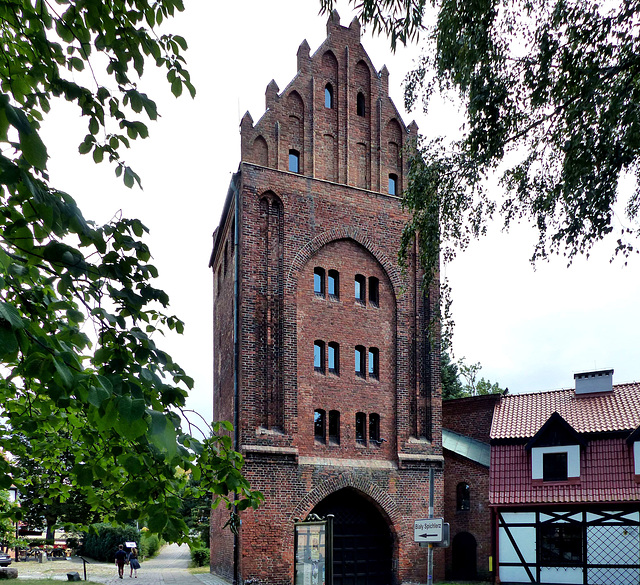Location
See also...
Keywords
Authorizations, license
-
Visible by: Everyone -
All rights reserved
-
53 visits
Slupsk - Brama Mlyńska


Słupsk (Stolpe) was a Pomeranian settlement in the early Middle Ages. The Dukes of Pomerelia granted the town charter (Lübsches Stadtrecht) in 1265. A decade later merchants and craftsmen from Westphalia and Holstein founded a new settlement.
In 1294 Polish and Bohemian rulers tried to succeed in Pomerelia. Wenceslaus III awarded Stolp to the Brandenburg Ascanians After the fatal attempt on Wenceslas III's life, Wladyslaw I Ellenlang (aka "Ladislaus the Short") reasserted himself as ruler of Pomerelia in 1306 and declared themselves Brandenburg vassals in 1307.
In 1308, the Brandenburg margraves invaded and tried to militarily enforce their previously acquired rights. However, they were ousted from Gdansk and the eastern parts of Pomerelia by the Teutonic Knights. However, they were able to hold their ground in the land of Stolp.
In 1309, the Duchy of Pomerelia was divided between two feudal states. The western part went to the Brandenburgs, the larger rest including Danzig to the Teutonic Order. After Stolp became prosperous, the citizens acquired the port of Stolpmünde in 1337. In the 14th century the city was pledged to the Teutonic Order by the Pomeranian dukes, who were short of money because of numerous wars. Because the dukes could not redeem the town, but the inhabitants did not want to live under the rule of the Order, the citizens themselves raised the enormous redemption sum of 6,766 silver marks.
In devastating fires of 1395 and 1477 the town burned down. In 1478 the plague raged in the town. A dispute with the dukes that lasted for years impoverished the town and forced it to leave the Hanseatic League. During the Thirty Years' War, Stolp was conquered by Swedes in 1630. Wallenstein's troops occupied the town in 1637, and Swedish troops drove them out and completely ruined Stolp. After the war ended in 1648, Stolp fell to Brandenburg in the Peace of Westphalia.
Brama Mlyńska (Mill Gate) is part of the city fortifications.
The fortifications were erected between the early 14th century and the mid-15th century. The 6.5 m high walls surrounded the town. This was one of three gates. The Mill Gate led to the town from the east, connecting to a road leading to Gdansk. The walls were also defended by the waters of the Slupia River.
After the front had moved further west, the Old Town was set on fire by the Red Army. The gate was secured in ruins. Its rebuilding and renovation took place in 1965.
In 1294 Polish and Bohemian rulers tried to succeed in Pomerelia. Wenceslaus III awarded Stolp to the Brandenburg Ascanians After the fatal attempt on Wenceslas III's life, Wladyslaw I Ellenlang (aka "Ladislaus the Short") reasserted himself as ruler of Pomerelia in 1306 and declared themselves Brandenburg vassals in 1307.
In 1308, the Brandenburg margraves invaded and tried to militarily enforce their previously acquired rights. However, they were ousted from Gdansk and the eastern parts of Pomerelia by the Teutonic Knights. However, they were able to hold their ground in the land of Stolp.
In 1309, the Duchy of Pomerelia was divided between two feudal states. The western part went to the Brandenburgs, the larger rest including Danzig to the Teutonic Order. After Stolp became prosperous, the citizens acquired the port of Stolpmünde in 1337. In the 14th century the city was pledged to the Teutonic Order by the Pomeranian dukes, who were short of money because of numerous wars. Because the dukes could not redeem the town, but the inhabitants did not want to live under the rule of the Order, the citizens themselves raised the enormous redemption sum of 6,766 silver marks.
In devastating fires of 1395 and 1477 the town burned down. In 1478 the plague raged in the town. A dispute with the dukes that lasted for years impoverished the town and forced it to leave the Hanseatic League. During the Thirty Years' War, Stolp was conquered by Swedes in 1630. Wallenstein's troops occupied the town in 1637, and Swedish troops drove them out and completely ruined Stolp. After the war ended in 1648, Stolp fell to Brandenburg in the Peace of Westphalia.
Brama Mlyńska (Mill Gate) is part of the city fortifications.
The fortifications were erected between the early 14th century and the mid-15th century. The 6.5 m high walls surrounded the town. This was one of three gates. The Mill Gate led to the town from the east, connecting to a road leading to Gdansk. The walls were also defended by the waters of the Slupia River.
After the front had moved further west, the Old Town was set on fire by the Red Army. The gate was secured in ruins. Its rebuilding and renovation took place in 1965.
- Keyboard shortcuts:
Jump to top
RSS feed- Latest comments - Subscribe to the comment feeds of this photo
- ipernity © 2007-2024
- Help & Contact
|
Club news
|
About ipernity
|
History |
ipernity Club & Prices |
Guide of good conduct
Donate | Group guidelines | Privacy policy | Terms of use | Statutes | In memoria -
Facebook
Twitter

Sign-in to write a comment.